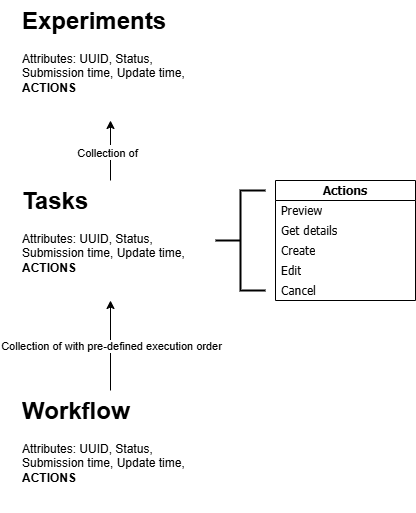Architecture
SCHEMA lab
SCHEMA-Lab is designed to manage tasks, workflow tasks, and experiments in a cohesive and efficient manner. At its core, it provides a platform for users to interact with different task types, perform operations like creating, editing, and canceling tasks, and group tasks into experiments for more organized management.
Key Components
Tasks:
Single Tasks: These represent individual units of work that can be created, executed, and monitored. Each task has its own lifecycle, which includes creation, execution, monitoring, and cancellation.
Workflow Tasks: These tasks are more complex and are typically composed of multiple single tasks. Workflow tasks are designed to manage a sequence of operations, where the execution of tasks can be dependent on the results of others.
Operations: For both single tasks and workflow tasks, developers can perform common actions such as previewing tasks, creating new ones, editing existing tasks, and canceling ongoing tasks.
Experiments:
An experiment in SCHEMA-Lab is a collection or group of single tasks. This allows for organized management and tracking of tasks that are logically grouped together for a specific experiment.
Operations on Experiments: Like tasks, experiments can be previewed, created, and edited. Developers can manage the grouping of tasks, edit experiment details, and view results for the entire experiment.
Dashboard:
- The dashboard acts as the central hub to manage and view tasks, workflow tasks, and experiments. It provides an overview of all the tasks and experiments currently active, as well as options to interact with them (e.g., creating, editing, canceling tasks or experiments).
Workflow Overview
Task Creation: Developers create single tasks or workflow tasks. For workflow tasks, a set of single tasks is defined, and the workflow tasks are executed in a predefined sequence or parallel manner.
Task Execution: Both regular tasks and workflow tasks go through an execution phase where they are monitored in real-time. Execution can be tracked, and tasks can be paused, resumed, or canceled as needed.
Experiment Creation: An experiment is created by grouping multiple tasks. Experiments allow for easier management of related tasks and provide a higher-level view of task performance and status.
Task Management: Once tasks are created, developers can edit the task details or cancel a running task if necessary. For experiments, developers can manage the entire experiment lifecycle, which includes adding or removing tasks, and editing or deleting experiments.
Diagram
The diagram below illustrates the architecture and flow of SCHEMA-Lab, showcasing the key components involved in managing tasks, workflow tasks, and experiments. It visualizes how tasks are created, executed, and grouped into experiments, as well as how developers interact with the platform’s various features to manage their workflows efficiently.
